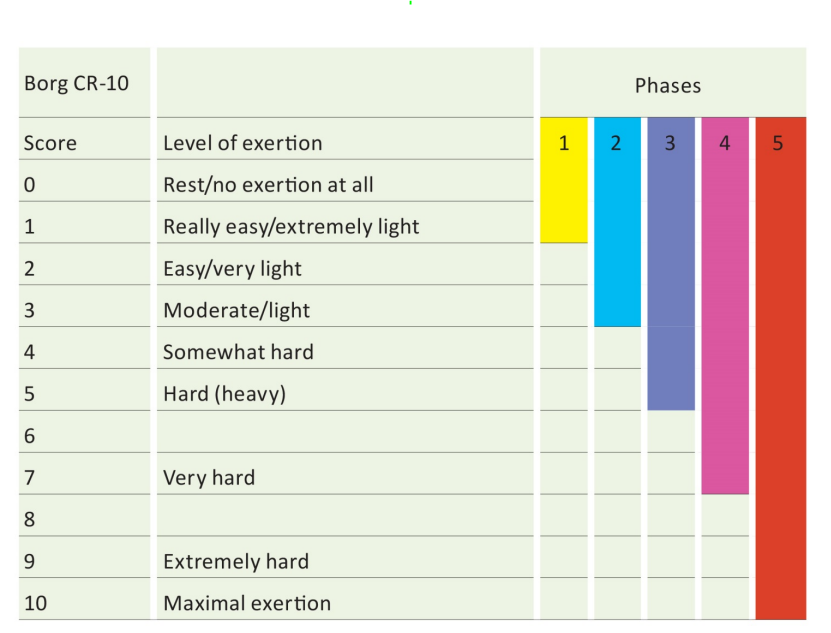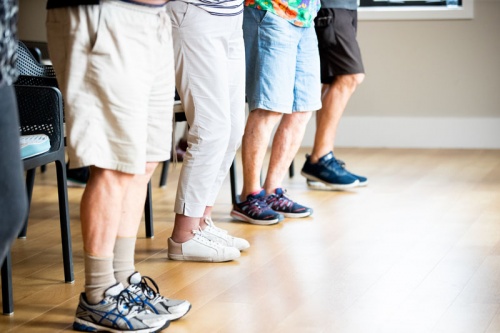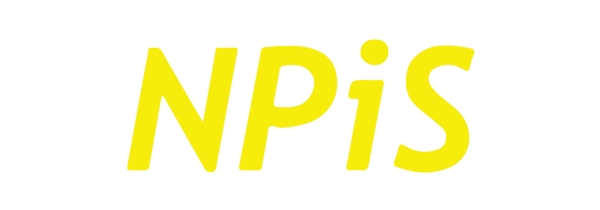Being ill with COVID-19 can cause your muscles to become weaker. Exercise is important for regaining your muscle strength and endurance
But this needs to be safely managed alongside your other COVID-19 symptoms.
When you start exercising after having covid you might find your symptoms get worse or you may feel very tired or have sore muscles after even a very small amount of activity (including work, gardening or housework. This is known as post-exertional malaise or PEM, and it is an important part of recovery after COVID-19.
- PEM can happen hours or days after physical or mental exertion.
- Recovery usually takes 24 hours.
- If you experience PEM, you need to avoid exercise and activities that cause fatigue or symptoms and conserve your energy
- If you don’t experience PEM, you can gradually increase your level of activity or exercise.
How do I get back to exercise?
RPE Scale

Phases of exercise
Consider your return to exercise in five phases; the following sections describe these phases and give suggestions for activities. Stay at each phase for a minimum of seven days before progressing to the next. Drop back a phase if you find it difficult or experience setbacks in your symptoms. If you experience any “red flag” symptoms such as chest pain or dizziness, you should stop immediately and not restart your exercise programme until you have been seen by a health care professional.
Phase 1. Preparation for return to exercise (your RPE score of 0–1) Some examples: are controlled breathing exercises, gentle walking, stretching and balance exercises. If your RPE score for any of these is more than 1, do not do them in this phase.
Phase 2. Low-intensity activity (your RPE score of 2–3) Examples: walking, light household/garden tasks. If your RPE score for any of these is more than 3, do not do them in this phase. If you can tolerate RPE scores of 2–3, you can gradually increase the time spent in exercises by 10–15 minutes per day. You’ll need to spend at least seven days in this phase without crashing (post-exertional malaise (PEM)) before progressing to the next level.
Phase 3. Moderate-intensity activity (your RPE score of 4–5) Examples: brisk walking, going up and down stairs, jogging, introducing inclines, and resistance exercises. If your RPE score for any of these is more than 5, do not do them in this phase.
Phase 4. Moderate-intensity exercises with coordination and functioning skills (your RPE score of 5–7) Some examples: running, cycling, swimming and dance classes. If your RPE score for any of these exercises is more than 7, do not do them in this phase
Phase 5. Return to your baseline exercises (your RPE score of 8–10) You’re now able to complete your usual pre-COVID-19 regular exercise/sports/ activity regime. No exercise should be painful. If you experience pain, chest pain, or feel faint or dizzy during exercise, you should stop immediately and not restart your exercise programme until you have been seen by a health care professional.

See your GP for a referral to Physiotherapy if you have any ongoing concerns
